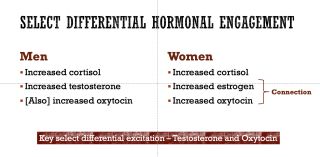Stress
Stress Reactive Variations in Men and Women
Men and women are indeed different.
Posted April 2, 2023 Reviewed by Jessica Schrader
Key points
- Men and women differ due to evolutionary-driven biological and psychosocial roles.
- Stress reactivity can result in considerable behavioral variation in men and women.
- Testosterone, estrogen, and oxytocin explain a great deal.

One point that is tremendously important, but frequently misunderstood, is the variance in stress reactivity between men and women. Let me start by stating that this post is not dealing with the complexities or charged emotional and political concepts of gender or sexuality. I am referring entirely to the science-based concept of evolutionary-driven biological factors involving physiological differences in men and women.
Men and women demonstrate considerable variation in their hormonal responses to stress, which leads to different behaviors (Pooley, et al., 2018; Verma et al., 2011). During stressful reactions, men have significantly higher levels of testosterone and cortisol and more activation in the amygdala (Goldstein et al., 2010; Olff, 2017; Verma et al., 2011). Conversely, women produce higher levels of estrogen and oxytocin (Goldstein et al., 2010; Olff, 2017; Pooley, 2018; Verma et al., 2011).
Oxytocin is a somewhat misunderstood molecule, often misleadingly referred to as the “love hormone.” Oxytocin is relevant in reducing stress reactivity and inducing calming, supportive atmospheres. Oxytocin is a hormone responsible for many activities during and after childbirth. Psychologically, it is associated with social support, nurturing, and bonding (Olff, 2017; Pooley, 2018). Oxytocin has been reported to mitigate amygdala activity, reducing sympathetic stimulation in women (Sessa, 2017). Additionally, oxytocin leads to increased feelings of trust and a heightened ability to provide social support (Goldstein et al., 2010; Olff, 2017; Pooley, 2018; Verma et al., 2011).
As a result of increased testosterone and amygdala responses, men are more likely to respond to stress with aggressiveness and emotional reactions, leading to the traditional fight reaction. Women with higher estrogen and oxytocin hormones drift toward tend, mend, and befriend reactions. In addition to sociocultural and developmental conditioning, hormonal differences explain why men are more inclined to react with violence and women with freezing, placating, or bonding (Verma et al., 2011). This makes evolutionary sense, as men were required to provide protection: to fight predatory animals and competing clans. Additionally, researchers have found that men have greater HPA activation compared with women and that this increased HPA axis excitation increases the risk of stress-related disorders (Holloway et al. 2020; Stephens et al., 2016).
From our ancestors' perspective, it was necessary for females (particularly during mid menstrual cycle) to have increased cortical capacity (meaning that they could deal with higher levels of cortisol) and lowered excessive arousal, enabling them to maintain more logical functioning capacity (Goldstein, 2010). For example, our ancestral females had to be able to evaluate an approaching male and determine if that male presented an opportunity for successful mating or served as a threat and they had to maintain the social structure of the clan (Goldstein, 2010; Olff, 2017; Pooley, 2018; Verma et al., 2011).
To accomplish this, females have been provided with a hormonal capacity to regulate the stress response that differs from males. Women have higher levels of binding proteins that prevent hyperarousal of HPA functioning, reducing the hormonal impacts of stress-reactive processes (Holloway et. al., 2023). As mentioned, men, on the other hand, are more likely to have hyperaroused HPA axes, leading to increased dysregulation of hormonal homeostasis. This regulatory mechanism was necessary for females, but unnecessary from an evolutionary point of view for the male, who had primary responsibility for the protection of his social unit, necessitating a fight or flight behavioral response supported by the need for increased testosterone.
Interestingly, oxytocin’s effect on men still produces a bonding effect like for women, but given that testosterone is driving men to aggression, the oxytocin bonding effect leads men to bond with their comrades in fighting—not the bonding to calm and develop relationships that occurs with women due to estrogen’s effects. In other words, men can become more aggressive when oxytocin is increased (Anpilov et. al., 2020).
So much for oxytocin being unwaveringly considered the “love hormone."


